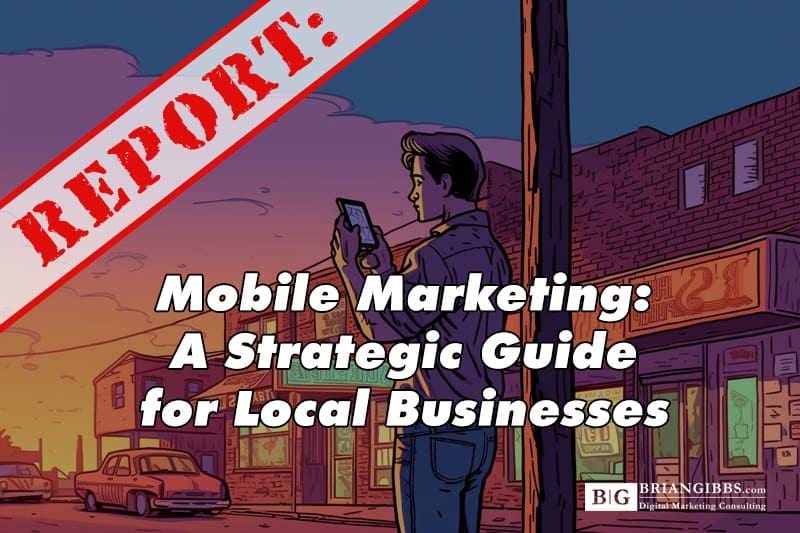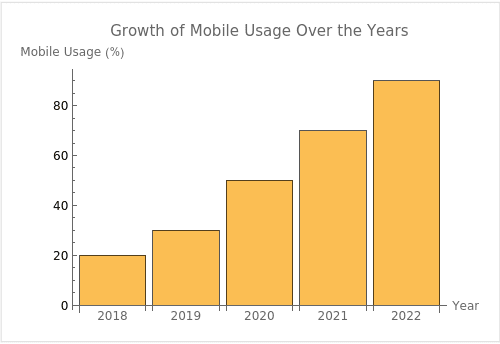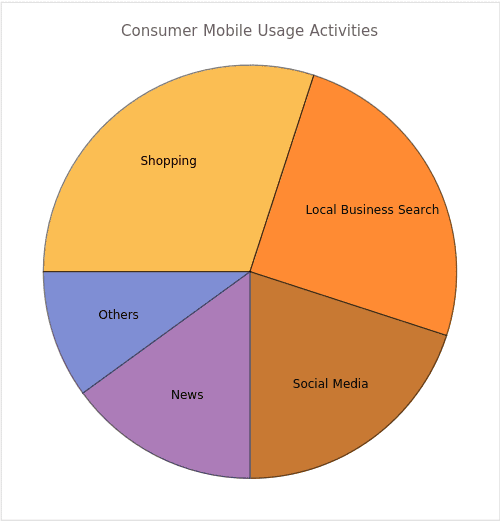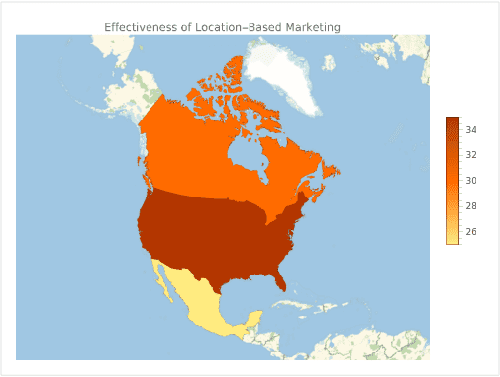Mobile Marketing: A Strategic Guide for Local Businesses
 In the digital dawn of the 21st century, the world has seen a seismic shift in the way businesses operate. The advent of smartphones and the ubiquity of mobile internet have transformed the business landscape, creating a new frontier for marketing. This white paper aims to illuminate the importance of mobile marketing for local businesses, a topic that is often overlooked yet holds immense potential for growth and success.
In the digital dawn of the 21st century, the world has seen a seismic shift in the way businesses operate. The advent of smartphones and the ubiquity of mobile internet have transformed the business landscape, creating a new frontier for marketing. This white paper aims to illuminate the importance of mobile marketing for local businesses, a topic that is often overlooked yet holds immense potential for growth and success.
The Importance of Mobile Marketing for Local Businesses
Imagine a world where your business is at the fingertips of every potential customer in your locality. A world where your products or services are just a tap away. This is not a fantasy, but a reality made possible by mobile marketing.
Mobile marketing is like the metaphorical key to the city, opening doors to a vast array of opportunities for local businesses. It’s the modern-day equivalent of a town crier, but instead of shouting in the town square, it whispers directly into the ears of your potential customers through their smartphones.
In an era where smartphones are as ubiquitous as the air we breathe, mobile marketing has become an essential tool for local businesses. It allows them to reach customers in real-time, with personalized messages that resonate with their needs and preferences. It’s like having a personal concierge for each customer, guiding them to your business and helping them find exactly what they need.
Purpose and Scope of the White Paper
This white paper serves as a beacon, guiding local businesses through the labyrinth of mobile marketing. It aims to demystify the concept, break down its components, and provide practical strategies for implementation.
The scope of this paper is broad yet focused. It covers the fundamentals of mobile marketing, explores its various facets, such as mobile apps, SMS marketing, and location-based services, and delves into strategies for effective implementation. It’s like a compass, pointing local businesses in the right direction and helping them navigate the mobile marketing landscape.
In essence, this white paper is a roadmap, charting a course for local businesses to harness the power of mobile marketing. It’s a journey of discovery, exploration, and empowerment. So, buckle up and get ready for a ride into the exciting world of mobile marketing for local businesses.
Understanding the Mobile Landscape
Current Statistics and Trends Related to Mobile Usage

This bar chart shows the increase in mobile usage over the years.
In the realm of mobile technology, the numbers speak for themselves. As of 2022, the number of smartphone mobile network subscriptions worldwide reached almost 6.6 billion, and this figure is forecast to exceed 7.8 billion by 2028, according to Statista. This staggering growth is a testament to the ubiquity of mobile devices in our lives.
The mobile landscape is akin to a bustling metropolis, teeming with activity and constantly evolving. It’s a world where the smartphone is king, and the citizens are the billions of users who interact with their devices on a daily basis.
Impact of Mobile Devices on Consumer Behavior
The impact of mobile devices on consumer behavior is akin to the effect of a magnet on iron filings. It’s a force that draws consumers in and profoundly shapes their behavior. A study published in the journal “Privacy in targeted advertising on mobile devices: a survey” highlights how targeted advertising, facilitated by mobile devices, has transformed the marketing landscape by creating new opportunities for advertisers to reach prospective customers with personalized ads.
Mobile devices have become a digital compass, guiding consumers‘ purchasing decisions. They influence where consumers shop, what they buy, and how they interact with brands. In essence, mobile devices have not just changed consumer behavior; they have redefined it.
Importance of Mobile Optimization for Websites and Applications
In the mobile-centric world, we live in, mobile optimization is not just important; it’s essential. It’s like the blueprint for a building; without it, the structure is likely to crumble. Websites and applications that are not optimized for mobile devices can lead to poor user experiences, lower search engine rankings, and, ultimately, lost business opportunities.
A paper titled “Distributed and adaptive location identification system for mobile devices” discusses the need for seamless navigation as users move from a GPS-clear outdoor environment into an indoor or GPS-obstructed outdoor environment. This highlights the importance of mobile optimization in providing a seamless user experience, regardless of the user’s environment.
Understanding the mobile landscape is crucial for local businesses. It’s like understanding the lay of the land before embarking on a journey. With this understanding, businesses can navigate the mobile landscape effectively and harness its potential to achieve their marketing goals.
Defining Mobile Marketing Strategies
Overview of Various Mobile Marketing Channels and Tactics
In the vast ocean of mobile marketing, businesses can use numerous channels and tactics to reach their audience. These channels are like the different currents in the ocean, each with its unique characteristics and potential.
- Mobile Applications: Mobile apps are like personal assistants, providing users with a variety of services at their fingertips. They can be used to deliver personalized content, offer exclusive deals, and enhance customer engagement.
- SMS Marketing: SMS marketing is like a postman, delivering messages directly to the user’s inbox. It’s a powerful tool for sending timely and relevant information to customers.
- Location-Based Services: These services are like GPS, guiding businesses to their target audience. They allow businesses to deliver personalized content based on the user’s location.
- Mobile Advertising: Mobile ads are like billboards on the digital highway. They can be used to increase brand awareness, drive traffic, and generate sales.
- Social Media Marketing: Social media platforms are like virtual town squares, where businesses can engage with their audience, share content, and build relationships.
Unique Opportunities and Challenges of Mobile Marketing for Local Businesses
Mobile marketing presents a plethora of opportunities for local businesses. It’s like a treasure chest, filled with potential rewards. However, like any treasure chest, it also comes with its set of challenges.
Opportunities:
- Personalization: Mobile marketing allows businesses to deliver personalized content to their audience, enhancing customer engagement and loyalty.
- Real-Time Marketing: With mobile devices, businesses can reach their audience in real-time, delivering timely and relevant content.
- Increased Reach: Mobile devices have a high penetration rate, allowing businesses to reach a larger audience.
Challenges:
- Privacy Concerns: With the increased use of mobile devices, privacy concerns have become a major issue. Businesses need to ensure that they respect user privacy and comply with relevant laws and regulations.
- Ad Blockers: Ad blockers are on the rise, making it difficult for businesses to reach their audience through mobile advertising.
- Device Fragmentation: The variety of mobile devices and operating systems can make it challenging for businesses to ensure a consistent user experience.
Examples of Successful Mobile Marketing Campaigns for Local Businesses
- Starbucks: Starbucks has successfully leveraged mobile marketing through its mobile app. The app allows customers to order and pay for their drinks, earn rewards, and find nearby stores. It’s like a barista in your pocket, providing a seamless and convenient customer experience.
- Domino’s Pizza: Domino’s Pizza has used SMS marketing to increase sales. Customers can sign up for text alerts to receive special offers and discounts. It’s like having a pizza delivery guy on speed dial, ready to deliver hot deals straight to your inbox.
- Nike: Nike has used location-based services to enhance customer engagement. Through its Nike+ Run Club app, users can track their runs, get coaching tips, and share their achievements on social media. It’s like having a personal trainer and a cheering squad, all in one app.
These examples illustrate the power of mobile marketing for local businesses. They show that with the right strategy, businesses can harness the potential of mobile marketing to achieve their goals.
Targeting and Personalization

This pie chart shows the percentage of consumers who use their mobile devices for various activities.
Importance of Identifying and Understanding the Target Audience
In the realm of mobile marketing, understanding your target audience is akin to having a compass in a vast forest. It helps you navigate the landscape and ensures that your marketing efforts are directed toward the right people.
Identifying and understanding your target audience is crucial for several reasons. First, it allows you to tailor your marketing messages to resonate with your audience. Second, it helps you understand their needs, preferences, and behaviors, enabling you to provide solutions that meet their needs. Lastly, it enables you to allocate your marketing resources effectively, ensuring that your efforts yield the highest return on investment.
Techniques for Collecting and Utilizing Customer Data
Collecting and utilizing customer data is like mining for gold. It involves extracting valuable insights from the data and using them to enhance your marketing efforts.
There are several techniques for collecting customer data. These include:
- Surveys and Questionnaires: These tools allow you to gather direct feedback from your customers, providing insights into their needs, preferences, and behaviors.
- Website Analytics: Website analytics tools provide data on how users interact with your website. This can include information on the pages they visit, their time spent on the site, and their actions.
- Social Media Analytics: Social media platforms provide a wealth of data on your audience, including their demographics, interests, and interactions with your brand.
Once you’ve collected the data, you can utilize it in several ways. For instance, you can use it to segment your audience, tailor your marketing messages, and optimize your marketing strategies.
Strategies for Personalized Mobile Marketing Campaigns
Personalized mobile marketing campaigns are like tailor-made suits. They fit perfectly, resonate with the individual, and enhance their experience.
A study titled “Behaviorally targeted location-based mobile marketing” highlights how highly personalized marketing messages can increase sales4. The study suggests that firms should offer price promotions to consumers with low product category involvement and non-price promotions to consumers with high product category involvement, as these combinations elicit the least reactance and therefore result in a higher probability of buying.
Here are a few strategies for creating personalized mobile marketing campaigns:
- Segmentation: Divide your audience into distinct groups based on their characteristics, behaviors, or preferences. This allows you to tailor your marketing messages to resonate with each segment.
- Personalized Content: Create content that is tailored to the individual’s needs, preferences, or behaviors. This could include personalized product recommendations, tailored offers, or content that is relevant to the individual’s interests.
- Behavioral Targeting: Use data on the individual’s behaviors, such as their browsing history or purchase history, to deliver relevant marketing messages.
Location-Based Marketing
Benefits and Challenges of Location-Based Marketing
Location-based marketing is akin to a lighthouse, illuminating the path for your marketing efforts to reach the right audience at the right time. It enables businesses to deliver personalized content based on the user’s location, which enhances relevance and engagement. It’s like a real-time marketing tool, delivering timely and relevant content. Moreover, location data can provide valuable insights into customer behavior, helping businesses understand their audience better and optimize their marketing strategies.
However, navigating the seas of location-based marketing is not without its challenges. Privacy concerns are paramount as the use of location data increases. Businesses must respect user privacy and comply with relevant laws and regulations. The accuracy of location data can also vary, affecting the effectiveness of location-based marketing efforts. Furthermore, users need to opt-in to share their location data, which can limit the reach of location-based marketing campaigns.
Overview of Location-Based Technologies and Tools

This heat map shows the effectiveness of location-based marketing in different regions.
Various technologies and tools are available for location-based marketing. GPS technology, for instance, allows businesses to determine a user’s exact location, enabling precise targeting. Beacons, small devices that transmit signals to nearby mobile devices, allow businesses to send targeted messages to users in a specific location. Geofencing involves creating a virtual boundary around a specific location, triggering targeted messages when a user enters or leaves this area. Lastly, Location-Based Services (LBS) use location data to provide personalized services to users, including location-based advertising, location-based search, and location-based social media.
Case Studies of Successful Location-Based Marketing Campaigns
Several businesses have successfully leveraged location-based marketing. Starbucks, for example, drives foot traffic to its stores by sending notifications to users near a Starbucks store, inviting them to stop by for a coffee. It’s as if a friendly barista is personally inviting you in for a cup of coffee.
On the other hand, Uber uses location data to connect drivers and riders. When a user requests a ride, the app uses location data to find the nearest available driver, providing a service akin to having a personal chauffeur ready to pick you up wherever you are.
Walmart enhances the in-store experience using location-based services. When a user enters a Walmart store, they can use the Walmart app to navigate the store, find products, and check prices. It’s like having a personal shopping assistant guiding you through the store.
These examples illustrate the potential of location-based marketing. With the right strategy and tools, businesses can harness the power of location data to enhance their marketing efforts and achieve their goals.
Measurement and Analytics
Importance of Tracking and Measuring Mobile Marketing Efforts
In the world of mobile marketing, tracking and measuring your efforts is akin to a captain charting a course and monitoring the ship’s progress. It’s not enough to simply set sail; you need to know where you’re going, how fast you’re moving, and whether you’re on the right course. Similarly, tracking and measuring your mobile marketing efforts allows you to understand your campaigns’ effectiveness, identify improvement areas, and make data-driven decisions to optimize your strategies.
Overview of Key Mobile Marketing Metrics
Just as a ship’s captain relies on a variety of instruments to navigate the seas, marketers need to monitor a range of metrics to assess the performance of their mobile marketing campaigns. These metrics can include:
- User Engagement: This measures how users interact with your mobile app or website. Key indicators can include session duration, page views, and in-app actions.
- Conversion Rate: This measures the percentage of users who complete a desired action, such as making a purchase, signing up for a newsletter, or downloading an app.
- Retention Rate: This measures the percentage of users who return to your app or website after their first visit. A high retention rate indicates that your content is engaging and valuable to users.
- Churn Rate: This measures the percentage of users who stop using your app or website over a given period. A high churn rate can indicate problems with user experience or customer satisfaction.
Tools and Techniques for Analyzing and Optimizing Mobile Marketing Campaigns
Navigating the seas of mobile marketing requires the right tools and techniques. There are numerous analytics platforms available that can provide valuable insights into your mobile marketing efforts. These tools can help you track user behavior, measure campaign performance, and identify trends and patterns.
For example, Google Analytics for Mobile provides comprehensive data on user behavior, including session duration, bounce rate, and conversion rate. It also offers insights into user demographics and interests, helping you to better understand your audience.
Other tools, like Mixpanel and Amplitude, offer more advanced features, including event tracking, funnel analysis, and user segmentation. These tools can help you understand how users interact with your app, identify bottlenecks in your conversion funnel, and target specific user segments with personalized content.
In addition to these tools, A/B testing is a powerful technique for optimizing your mobile marketing campaigns. By testing different versions of your app or website, you can identify which features or designs resonate most with your audience and drive the best results.
Remember, the key to successful mobile marketing is not just to set sail, but to continually monitor your course, adjust your sails, and navigate towards your goals.
Conclusion
Summary of Key Points Discussed in the White Paper
As we draw the curtains on this enlightening journey through the realm of mobile marketing for local businesses, let’s take a moment to revisit the key points we’ve discussed.
We began our voyage by understanding the importance of mobile marketing for local businesses, highlighting how it’s no longer a luxury but a necessity in today’s digital age. We then delved into the mobile landscape, exploring current trends and the impact of mobile devices on consumer behavior.
Our journey continued as we defined various mobile marketing strategies, discussing the unique opportunities and challenges they present for local businesses. We highlighted the importance of targeting and personalization, emphasizing the need to understand the target audience and utilize customer data effectively.
We also explored the exciting world of location-based marketing, discussing its benefits, challenges, and the technologies that make it possible. We then discussed the importance of measurement and analytics, emphasizing the need to track and measure mobile marketing efforts and use the right tools and techniques for analysis and optimization.
Emphasis on the Potential Impact of Mobile Marketing on Local Businesses
As we’ve seen throughout our journey, mobile marketing holds immense potential for local businesses. It’s like a compass guiding businesses to their customers, helping them reach the right audience at the right time with the right message. From increasing visibility and engagement to driving sales and customer loyalty, mobile marketing can transform local businesses.
Encouragement for Businesses to Adopt Mobile Marketing Strategies
As we conclude, we encourage all local businesses to embark on their own journey in the world of mobile marketing. Just as a ship needs a skilled captain to navigate the seas, businesses need a well-planned mobile marketing strategy to navigate the digital landscape.
Remember, the journey may be challenging, and the seas may be rough at times, but the rewards can be immense with the right strategy, tools, and mindset. So, set your sails, chart your course, and embark on the exciting journey of mobile marketing. The horizon is full of opportunities waiting to be explored.
References
- Okazaki, S., & Li, H. (2016). Mobile Marketing: A Contemporary Strategic Perspective. International Journal of Advertising
- Lehmann, C. (2015). Mobile Marketing: From Marketing Strategy to Mobile Marketing Campaign Implementation. Springer Gabler
- Steenburgh, J., Gu, L., & Xu, Y. (2021). Behaviorally targeted location-based mobile marketing. Journal of the Academy of Marketing Science
- Car, T., Šerić, M., & Marković, A. (2014). Mobile Marketing and Advertising Strategies in Tourism and Hospitality Industry. Procedia Computer Science
- Rowles, D. (2017). Mobile Marketing: How Mobile Technology is Revolutionizing Marketing, Communications, and Advertising
- Khan, A., & Becker, M. (2015). Mobile Marketing: Strategies for Mobile Advertising. Routledge
- Statista. (2023). Number of smartphone users worldwide from 2016 to 2021
- Jia, J., Zhang, C., Zhang, N., & Zhao, P. (2022). Privacy in targeted advertising on mobile devices: a survey. Journal of Internet Services and Applications
- Zhang, Y., & Li, X. (2018). Distributed and adaptive location identification system for mobile devices. EURASIP Journal on Wireless Communications and Networking
